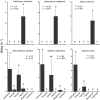Context-Dependent Diversity-Effects of Seaweed Consumption on Coral Reefs in Kenya
- PMID: 26673609
- PMCID: PMC4684473
- DOI: 10.1371/journal.pone.0144204
Context-Dependent Diversity-Effects of Seaweed Consumption on Coral Reefs in Kenya
Abstract
Consumers and prey diversity, their interactions, and subsequent effects on ecosystem function are important for ecological processes but not well understood in high diversity ecosystems such as coral reefs. Consequently, we tested the potential for diversity-effects with a series of surveys and experiments evaluating the influence of browsing herbivores on macroalgae in Kenya's fringing reef ecosystem. We surveyed sites and undertook experiments in reefs subject to three levels of human fishing influence: open access fished reefs, small and recently established community-managed marine reserves, and larger, older government-managed marine reserves. Older marine reserves had a greater overall diversity of herbivores and browsers but this was not clearly associated with reduced macroalgal diversity or abundance. Experiments studying succession on hard substrata also found no effects of consumer diversity. Instead, overall browser abundance of either sea urchins or fishes was correlated with declines in macroalgal cover. An exception was that the absence of a key fish browser genus, Naso, which was correlated with the persistence of Sargassum in a marine reserve. Algal selectivity assays showed that macroalgae were consumed at variable rates, a product of strong species-specific feeding and low overlap in the selectivity of browsing fishes. We conclude that the effects of browser and herbivore diversity are less than the influences of key species, whose impacts emerge in different contexts that are influenced by fisheries management. Consequently, identifying key herbivore species and managing to protect them may assist protecting reef functions.
Conflict of interest statement
Figures







Similar articles
-
Consumer diversity interacts with prey defenses to drive ecosystem function.Ecology. 2013 Jun;94(6):1347-58. doi: 10.1890/12-0389.1. Ecology. 2013. PMID: 23923498 Free PMC article.
-
Resource type influences the effects of reserves and connectivity on ecological functions.J Anim Ecol. 2016 Mar;85(2):437-44. doi: 10.1111/1365-2656.12460. Epub 2015 Nov 28. J Anim Ecol. 2016. PMID: 26476209
-
Diversity among macroalgae-consuming fishes on coral reefs: a transcontinental comparison.PLoS One. 2012;7(9):e45543. doi: 10.1371/journal.pone.0045543. Epub 2012 Sep 20. PLoS One. 2012. PMID: 23029083 Free PMC article.
-
Kenya.Mar Pollut Bull. 2001 Dec;42(12):1264-78. doi: 10.1016/s0025-326x(01)00241-7. Mar Pollut Bull. 2001. PMID: 11827110 Review.
-
Larval dispersal and movement patterns of coral reef fishes, and implications for marine reserve network design.Biol Rev Camb Philos Soc. 2015 Nov;90(4):1215-47. doi: 10.1111/brv.12155. Epub 2014 Nov 25. Biol Rev Camb Philos Soc. 2015. PMID: 25423947 Review.
Cited by
-
Selective consumption of macroalgal species by herbivorous fishes suggests reduced functional complementarity on a fringing reef in Moorea, French Polynesia.J Exp Mar Biol Ecol. 2021 Mar;536:151508. doi: 10.1016/j.jembe.2020.151508. Epub 2021 Jan 11. J Exp Mar Biol Ecol. 2021. PMID: 35530638 Free PMC article.
-
Trophic distribution of nutrient production in coral reef fisheries.Proc Biol Sci. 2023 Oct 11;290(2008):20231601. doi: 10.1098/rspb.2023.1601. Epub 2023 Oct 4. Proc Biol Sci. 2023. PMID: 37788704 Free PMC article.
References
-
- Adam TC, Burkepile DE, Ruttenberg BI, Paddack MJ. Herbivory and the resilience of Caribbean coral reefs: knowledge gaps and implications for management. Marine Ecology Progress Series. 2015;520:1–20.
-
- Bellwood DR, Hughes TP, Folke C, Nystrom M. Confronting the coral reef crisis. Nature. 2004;429:827–32. - PubMed
-
- Cheal A, MacNeil MA, Cripps E, Emslie M, Jonker M, Schaffelke B, et al. Coral–macroalgal phase shifts or reef resilience: links with diversity and functional roles of herbivorous fishes on the Great Barrier Reef. Coral reefs. 2010;29:1005–15.
Publication types
MeSH terms
Associated data
LinkOut - more resources
Full Text Sources
Other Literature Sources
Miscellaneous

